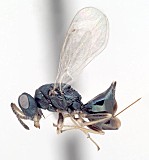Halticoptera
Remarks
Members of the genus Halticoptera are koinobiont larval or egg-larval parasitoids. Halticoptera daci Silvestri has been reared from pupae collected in the soil beneath wild olive trees in South Africa, and is thus thought to be a parasitoid of Bactrocera oleae (Neuenschwander 1982). Halticoptera laevigata has been collected from Anomoia purmunda infesting Crataegus, and Myoleja lucida and Rhagoletis cerasi infesting Lonicera in Europe (Hoffmeister 1992). Halticoptera rosae attack eggs of the rose hip infesting tephritid fly Rhagoletis basiola (Balduf 1959), leaving a marking pheromone at the oviposition site to deter superparsitism by conspecifics (Hoffmeister 2000) and also exploiting marking pheromone of the host (Hoffmeister et al. 2000). Hoffmeister et al. also report that in experimental studies, larger rose hip fruit size, which is preferred for fly oviposition, does not provide refuge from parasitoids (Hoffmeister et al. 1999). Halticoptera rosae show no preference for rose hip size and did not require more time to locate hosts on larger fruits than on small fruits, suggesting that the wasp may utilize host-marking pheromone trails.
See additional information on the Pteromalidae page.
Distribution
No referenced distribution records have been added to the database for this OTU.


